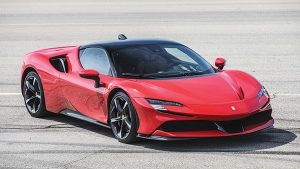The auto industry is set to be transformed by the shift to electric vehicles from internal combustion engines and the introduction (any day now, trust me on this one) of fully self-driving automation that will turn drivers into passengers. Ferrari NV is reluctantly (and slowly) participating in the former, but it’s resolutely against letting artificial intelligence get behind the wheels of its sports cars. “The AI guys had a ride with our test driver,†Ferrari Chief Executive Officer Benedetto Vigna said this week. “When they got out from a Ferrari they told me, ‘OK, Benedetto, our presentation is useless. No customer is going to spend money for the computer in the car to enjoy the drive.’â€
While Ferrari’s numbers — and not just its top speeds — look impressive, the Italian thoroughbred can’t afford to stand still, argues Chris Bryant. It needs to maintain the exclusivity that saw it sell barely 11,000 vehicles last year, retaining the mystique that lets the stock market treat it as a luxury brand with a market capitalization of 30 billion euros ($32 billion), rather than a metal-bashing production line. It needs to handle the launch of its SUV with care, given the ugliness of the sheds-on-wheels that Bentley and Lamborghini, among others, have brought to market. And it needs to continue avoiding becoming an old person’s brand.
But it’s the shift to electrification that could put the brakes on Ferrari’s profitability. Its first fully electric model won’t arrive until 2025, and even by 2030 the company expects hybrid and fully fossil-fueled vehicles to represent 60% of its model lineup. “There’s a risk that faster-moving rivals redefine what a luxury electric car looks and sounds like,†Chris warns. With the European Union demanding zero tailpipe emissions for all cars sold after 2035, Ferrari will need to rely on the tech expertise of its CEO to avoid falling behind. “I’m confident that with tech expert Vigna at the helm, Ferrari will eventually craft electric vehicles that are every bit as enviable as its gas-guzzlers,†Chris concludes.
This week has seen official interest rates increased by the Federal Reserve, the Bank of England, the Swiss National Bank and other guardians of monetary stability. More — and more aggressive — moves are anticipated in several jurisdictions as policy makers belatedly attempt to tame the inflation beast that’s roaring through the global economy. But Japan? Not so much.
Bank of Japan Governor Haruhiko Kuroda is doubling down on his strategy of maintaining an ultra-loose monetary policy stance, even as the yen slumped to a 24-year low this week.
 The Gulf Time Newspaper One of the finest business newspapers in the UAE brought to you by our professional writers and editors.
The Gulf Time Newspaper One of the finest business newspapers in the UAE brought to you by our professional writers and editors.
